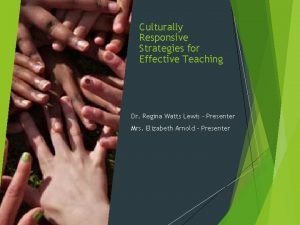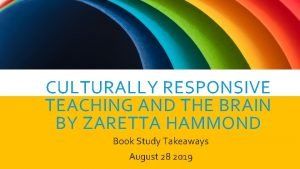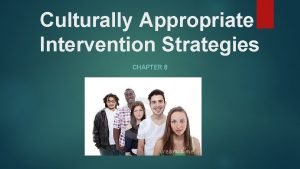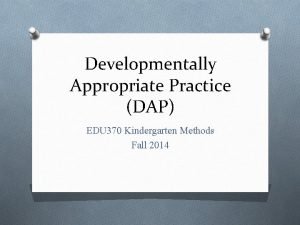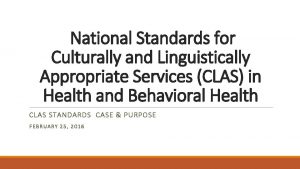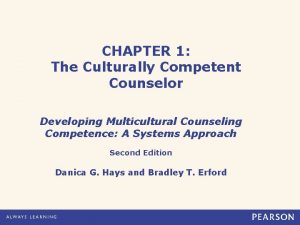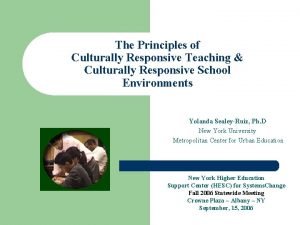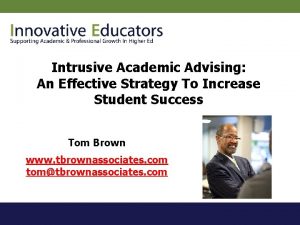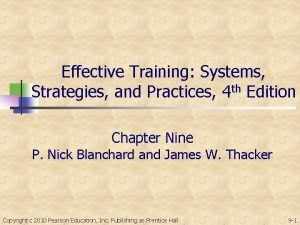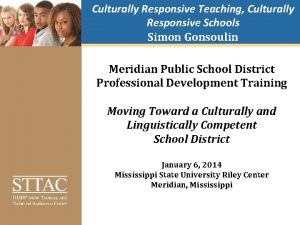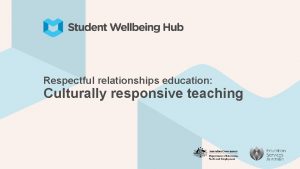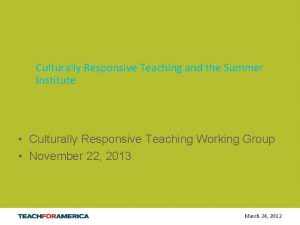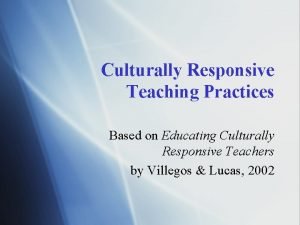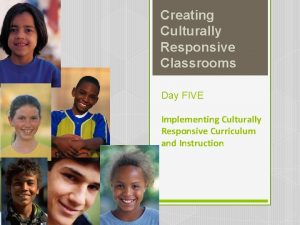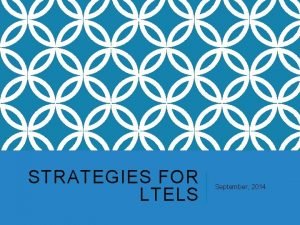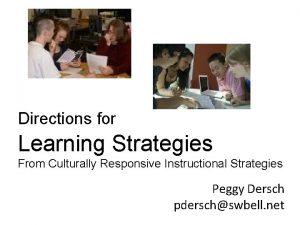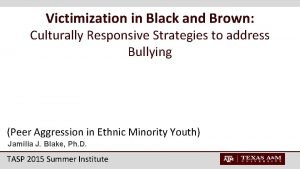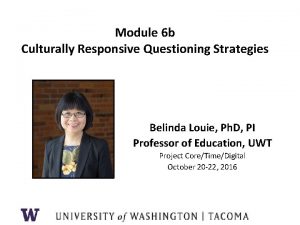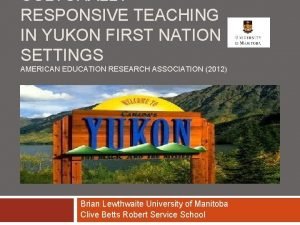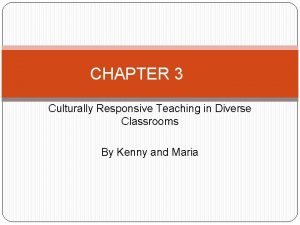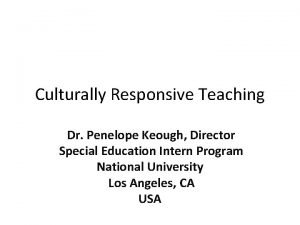Culturally Responsive Strategies for Effective Teaching Dr Regina

















- Slides: 17

Culturally Responsive Strategies for Effective Teaching Dr. Regina Watts Lewis – Presenter Mrs. Elizabeth Arnold – Presenter

Complete the Common Beliefs Survey Session Outline Teachers’ beliefs, explicit and implicit bias Every Student Succeeds Act (ESSA) and difference between equality and equity Cultural disconnect Six characteristics of culturally responsive teaching Culturally responsive teaching strategies Group activity Putting the Pieces Together Video (2: 47) Conclude presentation

Common Beliefs Survey 1. I don’t think of my students in terms of their race or ethnicity. I am color blind when it comes to my teaching. First Thoughts: Agree Strongly Neither Agree Nor Disagree 1 2 3 Disagree Strongly 4 5 Why I feel this way: ____________________________________________________________________________________ 3. Teachers should adapt their teaching to the distinctive cultures of African American, Latino, Asian, and Native American students. First Thoughts: Agree Strongly Neither Agree Nor Disagree 1 2 3 Disagree Strongly 4 5 Why I feel this way: ____________________________________________________________________________________ 5. When students come from homes where educational achievement is not a high priority, they often don’t do their homework and their parents don’t come to school events. This lack of parental support undermines my efforts to teach these students. First Thoughts: Agree Strongly 1 Neither Agree Nor Disagree 2 3 Disagree Strongly 4 5 Why I feel this way: ____________________________________________________________________________________ 7. I believe that I should reward students who try harder, even if they are not doing well in school; building their self-esteem is important. First Thoughts: Agree Strongly 1 Neither Agree Nor Disagree 2 3 Disagree Strongly 4 5 Why I feel this way: ____________________________________________________________________________________ 9. Students of different races and ethnicities often have different learning styles and good teachers will match their instruction to these learning styles. First Thoughts: Agree Strongly 1 Neither Agree Nor Disagree 2 3 Disagree Strongly 4 5 Why I feel this way: ____________________________________________________________________________________ “Reprinted with permission of Teaching Tolerance, a project of the Southern Poverty Law Center. www. tolerance. org”

Teachers’ Beliefs… begin before entering the classroom to teach; can be positive or negative; influences how teachers teach; should be examined within the context of race, ethnicity, culture, social class, gender, sexual orientation, disability, language, religion, and geography.

Explicit Bias & Implicit Bias Explicit bias Very clear about his or her feelings and attitudes, and related behaviors are conducted with intent. It is conscious and controllable. Implicit bias A behavior that arises from subconscious associations. It is normal and natural to our experience and often unavoidable. If unaddressed can lead to self-fulfilling prophecy. Examples of implicit bias include: Stereotyping certain groups, for example, “all teenagers are lazy”. Gifted students need no extra help. Instructors might treat students with physical disabilities as if they may also have mental disabilities, and thus require more attention. “Black students are suspended disproportionately and are more likely to be referred to the office for more subjective reasons”.

Equality Equity

The student population is becoming increasingly more diverse. When faces do not look like our own, some educators try to bridge this difference with color -blindness. Cultural Disconnect The alternative to color-blindness is multiculturalism. Celebrating and affirming differences. At its best, multiculturalism is an ongoing process of questioning, revising, and struggling to create greater equity in every aspect of school life. To engage students effectively in the learning process, teachers must know their students and their academic abilities individually.

Six Characteristics of Culturally Responsive Teaching 1. EMPOWERING Sets high standards and expectations, encourages academic competence, personal confidence, courage, and the will to act 4. COMPREHENSIVE Seeks to educate the whole child 2. MULTIDIMENSIONAL Engages cultural knowledge, experiences, contributions, and perspectives into the classroom, teaching methods, and evaluation 3. VALIDATING AND AFFIRMING Validates every student’s culture and bridges gaps through diversified strategies and multicultural curricula to make learning more relevant and effective 5. TRANSFORMATIVE Recognizes existing strengths and accomplishments of students and uses them to drive instruction, assessment, and curriculum design 6. LIBERATING Liberates students from traditional educational practices and ideologies typically taught in schools

Culturally Responsive Strategies for Effective Teaching: Tools for your Toolbox Welcoming each student by name when they enter the classroom, taking care to correctly pronounce everyone's name. This is a crucial signal that you value your student's presence and heritage. Understanding cultural and/or individual differences by asking questions demonstrates a desire to adapt your teaching style to students and help them feel valued. Including different cultures and languages in your curriculum. Children process content more effectively when their cultures and languages have places in the curriculum. Using vocabulary and language to build understanding before moving to academic diction, can keep students’ attention in any subject. Attention is the first step in learning. We cannot learn, remember, or understand what we don’t first pay attention to. Presenting relatable real-world problems gives students the opportunity to look for a cultural link and use their own cultural awareness to solve the problem. Sharing knowledge and learning with others across the globe via technology. It is an innovative way to internationalize learning within the traditional classroom.

Tools for your Toolbox Delivering different forms of content that include playing games, writing, illustrating, watching a video, reading an article, completing puzzles, listening to you teach. Varying instructional delivery that include tiered assignments, learning stations and centers, web quests, thinking maps, kinesthetic activities, literature circles. Integrating peer tutoring, cooperative grouping, flexible grouping, and think-pair-share activities into the lesson allow students to regularly learn and process content together. African American youth thrive on intense and sensitive peer relations. Using multiple teaching strategies daily helps to ensure that you are meeting the needs of all culturally diverse students. Consistency is key to being a more culturally responsive teacher. Setting clear expectations for behavior and learning. Enforce them equally for all students. Immersing oneself in multicultural experiences - It inspires creativity! Becoming a “life-long learner”.

Tools for your Toolbox Culturally Responsive Teachers are Introspective and Might Ask: What is the racial or gender breakdown of the students that I typically send from my class for disciplinary actions? How often do I send the same students for disciplinary actions? What messages am I communicating to the students who are the recipients of these actions? What messages am I communicating to their classmates? Is the behavior of my students getting better? How do I know? If it is not getting better, why not? Do I dispense disciplinary referrals fairly on the basis of race and gender? Are disciplinary actions therapeutic or simply punitive? Do I distinguish culturally specific behaviors from behavioral inadequacies? If students have substantial behavioral differences, have I taught them the skills that they need to know? Am I punishing students for my lack of skill in effective behavior management? Do I punish students because of my lack of skill in effective instruction?

Common Beliefs Survey Materials Common Beliefs Survey Common Beliefs Background Information with Questions to Consider Sheet SAMPLE Action Steps Sheet (use as a resource) Group Activity Calculate Average (add each members’ rating of belief statement/# of group members) Each Group Member Shares Rating of Belief Statement and “Why You Feel This Way” Read and Discuss “Common Beliefs Background Information” and “Questions to Consider” Sheet Identify At Least One Related “Action Step” that Might Help You and Others Better Serve Racially and Ethnically Diverse Students (Use SAMPLE Action Steps Sheet for Ideas) Share Common Beliefs Statement Average Rating for Group Brief Synopsis of Group Discussion and Comments Action Step


Resources Video Putting the Pieces of the Puzzle Together: Creating Culturally Responsive Learning Environment by Michael Henley Articles https: //study. com/academy/lesson/cult urally-relevant-teaching-strategiesdefinition-quiz. html C. A. R. E. : Strategies for Closing the Achievement Gaps, NEA Human and Civil Rights, can be downloaded at http: //www. nea. org/teachexperience/c areguide. html Minority Community Outreach Get news, event listings, and activity ideas for closing the achievement gaps from NEA's newly redesigned Minority Community Outreach website. http: //www. ascd. org/ascdexpress/vol 10/1019 -mayes. aspx http: //www. ascd. org/publications/book s/111022/chapters/Culturally. Responsive-Instruction. aspx http: //www. ascd. org/ascdexpress/vol 6/616 -cox. aspx http: //www. ascd. org/publications/book s/110004/chapters/Cultural-Congruencein-Instruction. aspx Books Cultural Competence: A Primer for Educators, Jerry V. Diller and Jean Moule, Thomson Wadsworth Teaching About Asian Pacific Americans, Edith Wen-Chu Chen and Glenn Omatsu, Rowman & Littlefield Publishers, Inc. ,

References Acquah, E. O. & Commins, N. L. (2013). Pre-service teachers’ beliefs and knowledge about multiculturalism. European Journal of Teacher Education, 36(4), 445 -463. doi: 10. 1080/02619768. 2013. 787593 Chiner, E. , Cardona-Moltó, M. , C. , & Puerta, J. M. G. (2015). Teachers' beliefs about diversity: An analysis from a personal and professional perspective. Journal of New Approaches in Educational Research, 4(1), 18 - 24 A. Dedeoglu, H. & Lamme, L. L. (2011). Selected demographics, attitudes, and beliefs about diversity of preservice teachers. Education and Urban Society 43(4), 468 -485. doi: 10. 1177/0013124510380718 Delpit, L. (2006). Other people’s children: cultural conflict in the classroom. New Press. Gay, G. (2002). Culturally responsive teaching. New York: Teachers College Press. http: //www. freepatentsonline. com/article/Exceptional-Children/176370871. html http: //www. nea. org/tools/30402. htm Jackson III, J. W. , “Cultural Disconnect!” 5 Adult Characteristics that Promote Negative Student Behavior # 67. Kalyanpur, M. (2003). A challenge to professionals: Developing cultural reciprocity with culturally diverse families. Focal Point, 17(1), 1– 6. Pang, V. O. , Stein, R. , Gomez, M. , Matas, A. , & Shimogori, Y. (2011). Cultural competencies: Essential elements of caring-centered multicultural education. Action in Teacher Education, 33, 560 -574. doi: 10. 1080/01626620. 2011. 627050 Sleeter, C. E. (2011 a). An agenda to strengthen culturally responsive pedagogy. English Teaching: Practice and Critique, 19(2), 7 -23. Sleeter, C. E. (2012). Confronting marginalization of culturally responsive pedagogy. Urban Education, 47(3), 562 -584. doi: 10. 1177/0042085911431472 Vanderford, R. A. & Oakley, N. (2018). 2018 Assessment results: Mississippi academic program, Mississippi Department of Education https: //www. mdek 12. org/sites/default/files/Offices/MDE/OEA/OPR/2018 -MAAP-Results. Presentation. pdf.

Contact Information Regina Watts Lewis, Ph. D. rewatts@harrison. k 12. ms. us 228 -539 -5957 Elizabeth Arnold earnold@harrison. k 12. ms. us 228 -539 -5956

Thank You! This Photo by Unknown Author is licensed under CC BY
 Culturally responsive vs culturally relevant
Culturally responsive vs culturally relevant Reach associates
Reach associates Vdoe culturally responsive teaching
Vdoe culturally responsive teaching Culturally responsive teaching and the brain powerpoint
Culturally responsive teaching and the brain powerpoint Culturally responsive teaching in music education
Culturally responsive teaching in music education Culturally responsive classroom management
Culturally responsive classroom management Culturally appropriate intervention strategies
Culturally appropriate intervention strategies Developmentally appropriate practice for kindergarten
Developmentally appropriate practice for kindergarten National culturally and linguistically appropriate services
National culturally and linguistically appropriate services Culturally competent counselor
Culturally competent counselor Culturally deprived meaning
Culturally deprived meaning Working with culturally and linguistically diverse families
Working with culturally and linguistically diverse families Leininger's sunrise model
Leininger's sunrise model Pedagogy meaning
Pedagogy meaning Leininger sunrise model
Leininger sunrise model Strategies for effective interpersonal communication
Strategies for effective interpersonal communication Intrusive academic advising
Intrusive academic advising Effective training systems strategies and practices
Effective training systems strategies and practices
